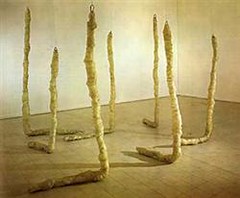Eva and Eva

Autumn Leaves - Eva Cassidy
People Get Ready - Eva Cassidy
It's too easy to posthumously read portentousness into an artist's work, particularly when they died tragically young. And I don't use that much-abused word, "tragically," often or lightly. Generally, I take a Aristotelian view of the concept, but I think an extremely talented woman dying at 34, at the peak of her talents, is tragedy by any definition.
Eva Hesse was an American painter and sculptor of wonderfully strange and beautiful works at a time and within a movement (1960s minimalism) that could be stern and frigid. Her best known pieces from the late 60s are fleshy, organic shapes, made with temporally unstable materials such as latex and rope. They're both playful and complex, psychologically penetrating and serious. Art historians, and anyone who knows her oeuvre and history, have made much of the fact that many of the fragile or gnarled, human tissue-like forms were created during the period she was diagnosed with a series of brain tumors. Following several surgeries, the tumors returned and Hesse died in 1970.
Is it a fallacy to use this kind of biographical information when interpreting works of art, and, more importantly, assigning value? I happen to think not--that whatever facts, surmises and personal feelings you bring to a reading are as valid as any rigid theoretical apparatus. But then, in whichever corner you stand the work of Eva Hesse is unassailable. I don't remember if I knew her story before I saw her art (it was a while ago when I was in college and knee-deep in art history) but I remember that seeing it in person, I was astonished by its craft and visceral immediacy, by the fact that it looked like nothing I had seen before. Knowing her training and process lent intellectual heft, but learning the biographical details made me love the work.
I was familiar with Eva Cassidy's story before I heard a note of her music. An extraordinarily versatile, virtually untrained vocalist, she performed jazz, soul, pop, folk and gospel standards in clubs around the Washington D.C. area to local acclaim, leaving only one solo live album when she died of melanoma in 1996. After her death, a BBC DJ played her rendition of "Over The Rainbow," opening a floodgate of interest in the singer and triggering a stream of patched-together releases.
At this juncture, I should say that this isn't normally my thing. I bought the Songbird CD (US, UK) as a gift for my mom, who loves female vocalists of the adult contemporary variety. But Cassidy's voice is so generous, so moving, that it transcends any notion of hipness or authenticity. And without forcing it, you can hear a sadness in her songs, but also something that says this: I may not be here long, but I'm going to make the most of it while I am.
It's life-afffirming, but is it art? Or do I allow biography to spin the music? I really couldn't say. And I don't know that I care.
If you're interested in learning more about Eva Hesse, I highly recommend Lucy Lippard's book (US, UK). Later this spring, Yale University Press releases a paperback catalogue for the San Francisco Museum of Modern Art's 2002 Hesse retrospective (US, UK).




4 Comments:
Thanks for the post Amy. SG is a long-time fan and introduced me to Eva Cassidy a while back. Her Fields of Gold cover is a personal favorite. And I'm told American Idol featured her Over The Rainbow rendition during the second season. What better endorsement!
Seriously though, I'm not very familiar with biographical details (though SG tells me that she had incredible stage fright), but I can say without hesitation that she has one of the most arresting voices I've ever heard.
JC
You're right to make the American Idol crack. But that's the odd thing about Eva Cassidy: the material can seem trite sometimes, but her voice is so usually good, it transcends it.
i agree with JC--the "Fields of Gold" cover is my favorite, followed by the litany of Cindy Lauper songs she recorded.
Sting--eek! And in my last comment I meant to say "unusually good."
Post a Comment
<< Home